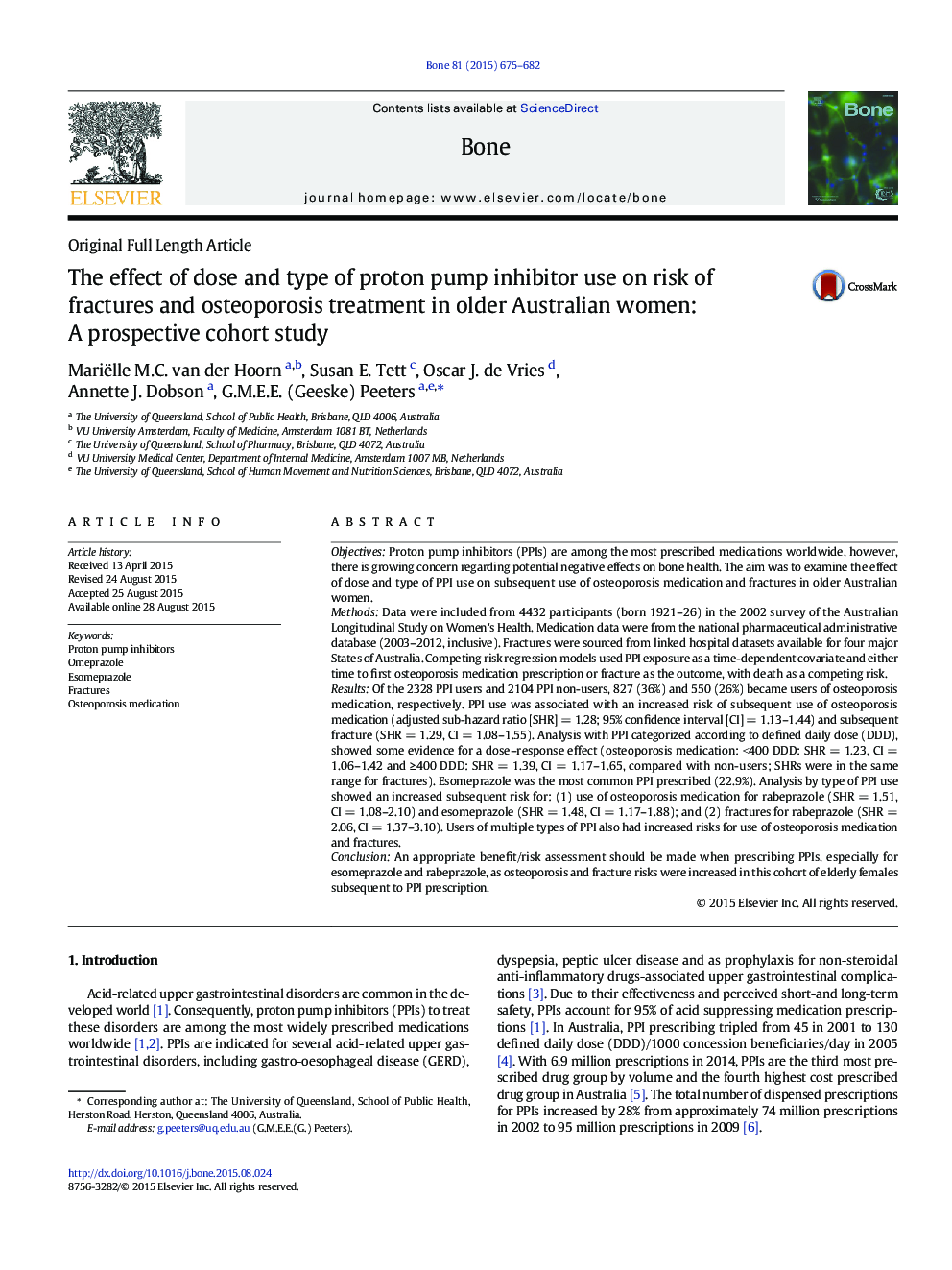| کد مقاله | کد نشریه | سال انتشار | مقاله انگلیسی | نسخه تمام متن |
|---|---|---|---|---|
| 5889366 | 1568138 | 2015 | 8 صفحه PDF | دانلود رایگان |
- Proton pump inhibitor (PPI) use in elderly (>Â 77Â years) women was associated with increased risk of decreased bone health.
- Increased risk of subsequent osteoporosis medication was associated with the most commonly prescribed PPI, esomeprazole.
- Rabeprazole, and use of multiple different PPIs, were associated with subsequent osteoporosis medication and fractures.
- There may be a dose-response relationship between PPI use and osteoporosis medication or fractures.
- Risks of harms need careful assessment before prescribing PPIs to ensure benefits outweigh potential adverse effects on bone.
ObjectivesProton pump inhibitors (PPIs) are among the most prescribed medications worldwide, however, there is growing concern regarding potential negative effects on bone health. The aim was to examine the effect of dose and type of PPI use on subsequent use of osteoporosis medication and fractures in older Australian women.MethodsData were included from 4432 participants (born 1921-26) in the 2002 survey of the Australian Longitudinal Study on Women's Health. Medication data were from the national pharmaceutical administrative database (2003-2012, inclusive). Fractures were sourced from linked hospital datasets available for four major States of Australia. Competing risk regression models used PPI exposure as a time-dependent covariate and either time to first osteoporosis medication prescription or fracture as the outcome, with death as a competing risk.ResultsOf the 2328 PPI users and 2104 PPI non-users, 827 (36%) and 550 (26%) became users of osteoporosis medication, respectively. PPI use was associated with an increased risk of subsequent use of osteoporosis medication (adjusted sub-hazard ratio [SHR] = 1.28; 95% confidence interval [CI] = 1.13-1.44) and subsequent fracture (SHR = 1.29, CI = 1.08-1.55). Analysis with PPI categorized according to defined daily dose (DDD), showed some evidence for a dose-response effect (osteoporosis medication: <400 DDD: SHR = 1.23, CI = 1.06-1.42 and â¥400 DDD: SHR = 1.39, CI = 1.17-1.65, compared with non-users; SHRs were in the same range for fractures). Esomeprazole was the most common PPI prescribed (22.9%). Analysis by type of PPI use showed an increased subsequent risk for: (1) use of osteoporosis medication for rabeprazole (SHR = 1.51, CI = 1.08-2.10) and esomeprazole (SHR = 1.48, CI = 1.17-1.88); and (2) fractures for rabeprazole (SHR = 2.06, CI = 1.37-3.10). Users of multiple types of PPI also had increased risks for use of osteoporosis medication and fractures.ConclusionAn appropriate benefit/risk assessment should be made when prescribing PPIs, especially for esomeprazole and rabeprazole, as osteoporosis and fracture risks were increased in this cohort of elderly females subsequent to PPI prescription.
Journal: Bone - Volume 81, December 2015, Pages 675-682
